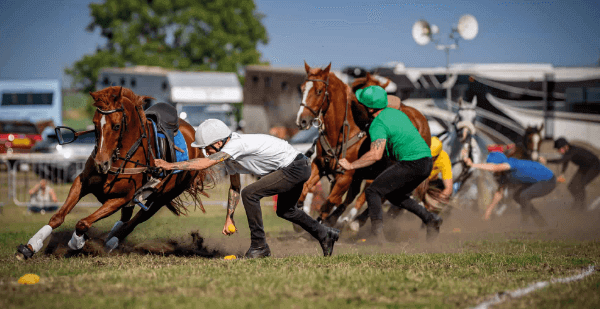What makes gymkhana a fun and engaging equestrian activity?

Introduction
Gymkhana is a dynamic equestrian sport that blends speed, agility, and skill. This thrilling activity is loved by riders of all ages for its engaging challenges and the camaraderie it fosters. From barrel racing to pole bending, gymkhana events offer a variety of exciting competitions that test both horse and rider. In this article, we’ll explore what makes gymkhana such a captivating and enjoyable equestrian activity.
What is Gymkhana?
Gymkhana is an equestrian event featuring a series of timed games on horseback. Originating from military cavalry exercises in India, the term “gymkhana” now refers to competitive horse games that emphasize precision, speed, and agility. Riders navigate various obstacle courses, perform intricate patterns, and demonstrate their horsemanship skills. Gymkhana events are designed to be fast-paced and challenging, making them a favorite among horse enthusiasts.
History of Gymkhana
The roots of gymkhana can be traced back to British colonial India, where cavalry officers practised manoeuvring their horses through complex drills. These exercises evolved into competitive games, and the term “gymkhana” was coined to describe these activities. Over time, gymkhana spread to other parts of the world, particularly gaining popularity in the United States and the United Kingdom. Today, gymkhana events are held globally, attracting participants from diverse backgrounds.
Types of Gymkhana Events
Gymkhana encompasses a wide range of events, each with its unique challenges. Some of the most popular gymkhana events include:
Barrel Racing: Riders navigate a cloverleaf pattern around barrels, aiming for the fastest time without knocking over any barrels.
Pole Bending: This event involves weaving through a series of poles in a serpentine pattern, testing the horse’s agility and the rider’s control.
Keyhole Race: Riders must enter and exit a keyhole-shaped pattern without stepping outside the boundaries, emphasizing precision and speed.
Flag Race: Competitors race to grab a flag from one barrel and place it in another, requiring coordination and quick reflexes.
Speed Ball: Riders race to drop a ball into a cone at the end of the arena and return as quickly as possible.
The Skills and Techniques Required for Gymkhana
Gymkhana demands a combination of speed, agility, and precise control. Riders must develop a deep understanding of their horses’ abilities and strengths. Key skills for gymkhana include:
Horsemanship: Proficient riding skills are essential for manoeuvring through obstacles and maintaining control at high speeds.
Timing: Successful gymkhana riders have excellent timing, allowing them to execute tight turns and quick transitions.
Communication: Clear communication between horse and rider is crucial, as it ensures the horse understands and responds to the rider’s cues.
Practice: Regular practice is vital for honing skills and improving performance. Many riders set up practice courses to simulate competition conditions.
The Social Aspect of Gymkhana
One of the most appealing aspects of gymkhana is the strong sense of community it fosters. Gymkhana events often bring together riders, families, and spectators, creating a supportive and inclusive environment. Participants cheer each other on, share tips and advice, and celebrate successes together. This camaraderie makes gymkhana not only a competitive sport but also a social activity that builds lasting friendships.
The Benefits of Participating in Gymkhana
Engaging in gymkhana offers numerous benefits, both physical and mental:
Physical Fitness: Riding and manoeuvring through obstacles provide a full-body workout, enhancing strength, balance, and coordination.
Mental Agility: Gymkhana challenges riders to think quickly and make split-second decisions, sharpening their mental acuity.
Confidence Building: Successfully navigating gymkhana courses boosts riders’ confidence and self-esteem.
Bonding with Horses: The close partnership required in gymkhana strengthens the bond between rider and horse, fostering trust and mutual respect.
Competitive Spirit: Gymkhana provides a healthy outlet for competition, encouraging riders to set goals and strive for improvement.
Gymkhana for Different Age Groups
Gymkhana is an inclusive sport that welcomes participants of all ages. Youth gymkhana events are designed to be accessible and fun, introducing young riders to the basics of competition. Adult gymkhana events offer more advanced challenges, catering to experienced riders looking to test their skills. Additionally, many gymkhana organizations offer divisions based on age and skill level, ensuring fair and enjoyable competition for everyone.
Gymkhana Equipment and Gear
Proper equipment is essential for safety and performance in gymkhana. Key items include:
Saddle and Bridle: A well-fitting saddle and bridle are crucial for maintaining control and comfort during events.
Helmet: Safety helmets are mandatory in many gymkhana events to protect riders from head injuries.
Boots: Riding boots with a sturdy heel provide stability and prevent slipping in the stirrups.
Protective Gear: Leg wraps and protective boots for horses help prevent injuries during high-speed maneuvers.
Setting Up a Gymkhana Course
Creating a gymkhana course requires careful planning and setup. Key steps include:
Choosing a Location: Select a flat, open area with sufficient space for the course layout.
Marking Obstacles: Use cones, barrels, and poles to mark the course, ensuring obstacles are securely placed.
Safety Considerations: Ensure the course is free of hazards and obstacles are properly spaced to prevent accidents.
Practising: Regularly practice the course to familiarize both horse and rider with the layout and improve performance.
Training Tips for Gymkhana Riders
Training for gymkhana involves a combination of riding exercises and conditioning drills. Key training tips include:
Consistency: Regular practice sessions help reinforce skills and build muscle memory.
Variety: Incorporate different exercises and patterns to keep training sessions engaging and challenging.
Fitness: Focus on both horse and rider fitness to ensure peak performance during competitions.
Patience: Progress may be gradual, so patience and persistence are essential for improvement.
Competing in Gymkhana Events
Competing in gymkhana requires preparation and a positive mindset. Key steps for competition day include:
Preparation: Ensure all equipment is in good condition and pack necessary supplies for the event.
Warm-Up: Spend time warming up your horse to prevent injuries and ensure they are focused and ready.
Focus: Stay calm and focused during events, trusting in your training and your horse’s abilities.
Sportsmanship: Display good sportsmanship by supporting fellow competitors and maintaining a positive attitude, regardless of the outcome.
Gymkhana Organizations and Associations
Several organizations and associations support gymkhana events and promote the sport. These groups provide resources, organize competitions, and offer training programs for riders. Notable gymkhana organizations include:
United States Gymkhana Association (USGA): A leading organization in the U.S. that hosts events and provides guidelines for competitions.
British Mounted Games Association (BMGA): Promotes gymkhana and mounted games in the UK, offering competitions and training for riders of all ages.
Local Riding Clubs: Many local riding clubs host gymkhana events and provide a supportive community for riders.
How to Get Started with Gymkhana
If you’re interested in trying gymkhana, here are some steps to get started:
Find a Club: Look for local riding clubs or associations that offer gymkhana events and training.
Take Lessons: Enroll in riding lessons to build foundational skills and confidence.
Attend Events: Watch gymkhana events to understand the competition format and get inspired by experienced riders.
Practice: Set up a practice course at home or at your riding facility to hone your skills.
FAQs
What makes gymkhana a fun and engaging equestrian activity? Gymkhana combines speed, agility, and precision, creating thrilling competitions that challenge both horse and rider. The variety of events and the supportive community atmosphere make gymkhana an enjoyable and engaging sport.
How does gymkhana benefit riders and horses? Gymkhana improves physical fitness, mental agility, and confidence in riders. It also strengthens the bond between rider and horse, enhancing trust and communication.
What equipment is needed for gymkhana? Essential gymkhana equipment includes a saddle, bridle, safety helmet, riding boots, and protective gear for the horse. Proper equipment ensures safety and performance during events.







